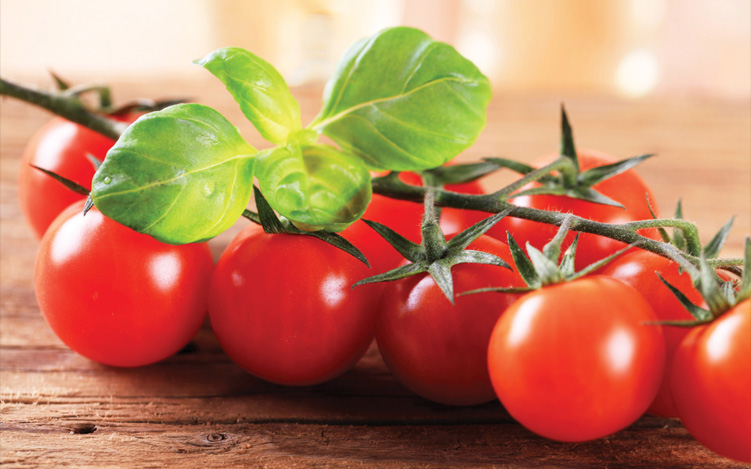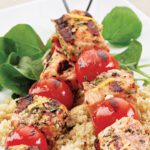Roses are red
Berries are blue
Red foods tastes good
And are heart-healthy, too.
There are only a few days of the year when a writer can get that corny, and who am I to pass up the chance? But it’s true. Lots of red foods are good for the heart because of what they have in them. And, because we eat first with our eyes, and red foods are pretty, there is no reason not to jump on the red food bandwagon.
Try this heart-healthy recipe from the American Heart Association:
GRILLED ROSEMARY-SALMON SKEWERS
Description
If you can find (or grow) them, use sturdy rosemary branches, stripped of leaves, as skewers for these Italian salmon kebabs; they’ll add a subtle, smoky flavor that hints of pine. Oil your grill well to prevent sticking, don’t move the kebabs around unnecessarily and keep a close eye on the fire to avoid flare-ups.
Ingredients
2 teaspoons minced fresh rosemary
2 teaspoons extra-virgin olive oil
2 cloves garlic, minced
1 teaspoon freshly grated lemon zest
1 teaspoon lemon juice
1/2 teaspoon kosher salt
1/4 teaspoon freshly ground pepper
1 pound center-cut salmon fillet, skinned (see Tip) and cut into 1-inch cubes
1 pint cherry tomatoes
Cooking Instructions
Preheat grill to medium-high.
Combine rosemary, oil, garlic, lemon zest, lemon juice, salt and pepper in a medium bowl. Add salmon; toss to coat. Alternating the salmon and tomatoes, divide among eight 12-inch skewers.
Oil the grill rack (see Tip). Grill the skewers, carefully turning once, until the salmon is cooked through, 4 to 6 minutes total. Serve immediately.
Cook’s Tip
How to skin a salmon fillet: Place skin-side down. Starting at the tail end, slip a long knife between the fish flesh and the skin, holding down firmly with your other hand. Gently push the blade along at a 30° angle, separating the fillet from the skin without cutting through either.
To oil the grill rack, oil a folded paper towel, hold it with tongs and rub it over the rack. (Don’t use cooking spray on a hot grill.)
Experts tout the many antioxidants in red foods. Not all scarlet foods have the same great free-radical fighters. And not all red foods work the same way. Think of strawberries as boxers, watermelons as wrestlers, red grapefruits as using karate, cherries as experts at tai chi, and tomatoes as rough and tumble streetfighters. They each get our bodies’ bad guys in their own way.
Lona Sandon, a professor of nutrition in Texas and spokesperson for the American Dietetic Association reports from WebMD that the antioxidants lycopene and anthocyanins in red foods take on heart disease and prostate cancer, as well as decrease the risk of stroke and macular degeneration. They soak up damaging free radicals.
Which Red Foods to Look For
Florida strawberries are a good source of folate that helps fight heart disease and is helpful for women during childbearing years. Lots of vitamin C boosts immune system function, among other things.
Cherries have plenty of fiber, vitamin C and potassium, that can help maintain proper blood pressure.
Cranberries don’t have to be just a holiday food. Sandon says, “Cranberries have been shown to cause the death of cancer cells in lab studies.”
Tomatoes are jam packed with lycopene that is linked to protection from prostate cancer. Tomatoes are also a good source of potassium and vitamin C, which makes them heart-healthy too. Funny thing about lycopene. There is more of it in a cooked tomato than a raw one. That’s good news for pasta and pizza fans.
And speaking of lycopene . . . watermelon is another fruit that supplies plenty of it. It might cut the risk of heart disease by reducing the amount of LDL in the blood.
Raspberries, also a good source of fiber, which can knock down that bad, old LDL, too.
Red grapefruit is better than pink that is better than white. There goes that “red is good for you” idea again. That’s because, like tomatoes and watermelon, red and pink grapefruit are packed with lycopene.
Wait a while and green peppers turn color on the plant. Red peppers have as much vitamin C as oranges. Who knew, right?
Cooking with Red Foods
Now that we know what red foods to look for, how are we going to use as many as possible in our diet?
Simple . . . cook with your eyes. Pick up Florida strawberries, peppers, grapefruit, and tomatoes. Buy red foods from someplace else when we don’t grow them.
Stock up on strawberries now when the prices should have moderated because of supply (Florida strawberries are currently in-season). Get some good freezer bags and set the kids to work hulling the berries. Wash before hulling and let them dry a bit before freezing. Pop them in the bags whole, if that’s the way you’re going to use them, or slice for parfaits and smoothies. Freezer jam is simple with packaged pectin and you know exactly what’s in it.
Tomatoes can take up any space left in the freezer after putting in the berries. Make a big pot of plain sauce— onion, garlic and tomatoes— and package it in meal-size containers. Get imaginative when you thaw it out for dinner. Add capers, black olives, more garlic, anchovies, and let it simmer to blend the flavors. Cook it down to top pizza.
I asked a server if there was meat in the spaghetti sauce and she said, “No, but we can break up a meatball in it. That’s how we make meat sauce.” You can do the same thing. Or, for a meatless meat, use vegetarian crumbles.
When tomatoes are on sale, cook up enough chili or Sloppy Joes base to last for weeks. Get a double-good whammy with more vegetarian crumbles instead of meat. If you do use meat, cook it the day before you want to use it and take the solid fat off before it goes into the tomato-sauce pot.
Red grapefruit from our tree does not need sugar. My wife would debate that. But agave or maple syrup do the trick. Enjoy red foods as often as you can. Your heart will thank you.
CREDIT
article by TRENT ROWE
Trent Rowe is the food editor of Central Florida Health News.

